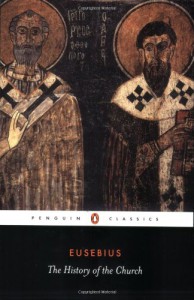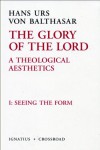
This is a very good book by the first great church historian. Eusebius (c. AD 264 – c. 340) was a devout Christian, scholar, historian, author, priest, and eventually the Bishop of Caesarea in Palestine. His “History of the Church” was the first book to record events in the life of the Church from the advent of Christ through the reign of Constantine. It proceeds chronologically and systematically, documenting the growth of the Church as it spread from Jerusalem throughout the whole of the Roman Empire and beyond. From the vast array of topics encompassed in that region and time, Eusebius focuses his history on five: the succession of bishops in the major churches from the apostles through his contemporaries, the corresponding succession of Roman emperors, the development of different heresies and the corresponding efforts to combat them, the canonization of Scripture, and the persecutions and martyrs of the Church.Each of these subjects is treated with care and attention to detail. The line of the bishops, by which the doctrine of apostolic succession is supported, is quite thorough, including occasional biographical sketches, as is the case with the emperors. But it is not hard to tell which topics are the most important to Eusebius: the persecutions of the martyrs and the heresies. More of the book is spent on these two topics than all the others combined. It is not hard to guess why that is so.In the case of the martyrs, Eusebius grew up as a Christian during the years of the great persecution under Diocletian. Not a few of his family members and friends were martyred for their faith, going willingly, even joyfully to their deaths. He spares no details in describing the brutal tortures they endured. That he devotes more space to the biographical sketches of the martyrs than to other topics is not surprising, and it is a great benefit for the Church today. It is important to remember what the early Church endured. It serves as an example for enduring suffering, and a spur to goad us to action to fight persecution when it appears today. In the case of the heresies, Eusebius was jealous for the purity of the Church. The heresies that plagued her through her early history were attacks on that purity committed mostly by self-interested men who sought to exploit her for personal power or wealth. Just as it was important for later generations to understand martyrdom and persecution, it was important for them to understand the heresies, so that they could be recognized when they reared their heads again, as they have repeatedly throughout history. In reading the stories of the martyrs and the heresies, it is easy to see the history of the early church in terms of a war for her purity fought on two fronts. One of those was external, represented by the imperial attacks in the form of state-sanctioned persecution. The other was internal, represented by the heretical teachings that surfaced. The contrast between the two could not be more stark, particularly with regard to the Church’s response. Christians went peacefully to their deaths. Not that there was no grief over the persecutions or no desire for them to cease, but there appeared to be no question of organized resistance against Rome. At no time did Christians take up arms against their terrible enemy. But against the heresies, the Church was relatively quick to organize against them, root them out and expel the heretics. In both cases, the end result was the same: the purity of the Church was upheld. Who but a true Christian would convert under the threat of death? Who but a true Christian remained when the heretics were exposed and expelled? Though I could easily go on about Eusebius and his book, I will make note of only two other items. First, with regard to the canon of Scripture, it is clear from reading Eusebius that establishing the canon was not so much a matter of people coming together to decide what books to include or exclude as part of God’s Holy Word as it was of acknowledging those books that the Church had already recognized as authoritative. This stands in sharp contradistinction to the ideas of many modern critics. Second, for the first three centuries of the Church, there was neither a central church nor a central individual in the Church. The true faith was not centered on Rome and there was no pope. Churches and bishops were all more or less viewed as equals. If the church in Jerusalem possessed somewhat more prestige, that was only because it was the first to be established. It had no more authority than any other church, nor did any bishop have more authority than another. In the case of controversies, councils were called and decisions made based on the authority of the Scriptures and the teaching of the apostles. This is not meant to be a critique of the Roman church today, merely an observation.
 This is a very good book by the first great church historian. Eusebius (c. AD 264 – c. 340) was a devout Christian, scholar, historian, author, priest, and eventually the Bishop of Caesarea in Palestine. His “History of the Church” was the first book to record events in the life of the Church from the advent of Christ through the reign of Constantine. It proceeds chronologically and systematically, documenting the growth of the Church as it spread from Jerusalem throughout the whole of the Roman Empire and beyond. From the vast array of topics encompassed in that region and time, Eusebius focuses his history on five: the succession of bishops in the major churches from the apostles through his contemporaries, the corresponding succession of Roman emperors, the development of different heresies and the corresponding efforts to combat them, the canonization of Scripture, and the persecutions and martyrs of the Church.Each of these subjects is treated with care and attention to detail. The line of the bishops, by which the doctrine of apostolic succession is supported, is quite thorough, including occasional biographical sketches, as is the case with the emperors. But it is not hard to tell which topics are the most important to Eusebius: the persecutions of the martyrs and the heresies. More of the book is spent on these two topics than all the others combined. It is not hard to guess why that is so.In the case of the martyrs, Eusebius grew up as a Christian during the years of the great persecution under Diocletian. Not a few of his family members and friends were martyred for their faith, going willingly, even joyfully to their deaths. He spares no details in describing the brutal tortures they endured. That he devotes more space to the biographical sketches of the martyrs than to other topics is not surprising, and it is a great benefit for the Church today. It is important to remember what the early Church endured. It serves as an example for enduring suffering, and a spur to goad us to action to fight persecution when it appears today. In the case of the heresies, Eusebius was jealous for the purity of the Church. The heresies that plagued her through her early history were attacks on that purity committed mostly by self-interested men who sought to exploit her for personal power or wealth. Just as it was important for later generations to understand martyrdom and persecution, it was important for them to understand the heresies, so that they could be recognized when they reared their heads again, as they have repeatedly throughout history. In reading the stories of the martyrs and the heresies, it is easy to see the history of the early church in terms of a war for her purity fought on two fronts. One of those was external, represented by the imperial attacks in the form of state-sanctioned persecution. The other was internal, represented by the heretical teachings that surfaced. The contrast between the two could not be more stark, particularly with regard to the Church’s response. Christians went peacefully to their deaths. Not that there was no grief over the persecutions or no desire for them to cease, but there appeared to be no question of organized resistance against Rome. At no time did Christians take up arms against their terrible enemy. But against the heresies, the Church was relatively quick to organize against them, root them out and expel the heretics. In both cases, the end result was the same: the purity of the Church was upheld. Who but a true Christian would convert under the threat of death? Who but a true Christian remained when the heretics were exposed and expelled? Though I could easily go on about Eusebius and his book, I will make note of only two other items. First, with regard to the canon of Scripture, it is clear from reading Eusebius that establishing the canon was not so much a matter of people coming together to decide what books to include or exclude as part of God’s Holy Word as it was of acknowledging those books that the Church had already recognized as authoritative. This stands in sharp contradistinction to the ideas of many modern critics. Second, for the first three centuries of the Church, there was neither a central church nor a central individual in the Church. The true faith was not centered on Rome and there was no pope. Churches and bishops were all more or less viewed as equals. If the church in Jerusalem possessed somewhat more prestige, that was only because it was the first to be established. It had no more authority than any other church, nor did any bishop have more authority than another. In the case of controversies, councils were called and decisions made based on the authority of the Scriptures and the teaching of the apostles. This is not meant to be a critique of the Roman church today, merely an observation.
This is a very good book by the first great church historian. Eusebius (c. AD 264 – c. 340) was a devout Christian, scholar, historian, author, priest, and eventually the Bishop of Caesarea in Palestine. His “History of the Church” was the first book to record events in the life of the Church from the advent of Christ through the reign of Constantine. It proceeds chronologically and systematically, documenting the growth of the Church as it spread from Jerusalem throughout the whole of the Roman Empire and beyond. From the vast array of topics encompassed in that region and time, Eusebius focuses his history on five: the succession of bishops in the major churches from the apostles through his contemporaries, the corresponding succession of Roman emperors, the development of different heresies and the corresponding efforts to combat them, the canonization of Scripture, and the persecutions and martyrs of the Church.Each of these subjects is treated with care and attention to detail. The line of the bishops, by which the doctrine of apostolic succession is supported, is quite thorough, including occasional biographical sketches, as is the case with the emperors. But it is not hard to tell which topics are the most important to Eusebius: the persecutions of the martyrs and the heresies. More of the book is spent on these two topics than all the others combined. It is not hard to guess why that is so.In the case of the martyrs, Eusebius grew up as a Christian during the years of the great persecution under Diocletian. Not a few of his family members and friends were martyred for their faith, going willingly, even joyfully to their deaths. He spares no details in describing the brutal tortures they endured. That he devotes more space to the biographical sketches of the martyrs than to other topics is not surprising, and it is a great benefit for the Church today. It is important to remember what the early Church endured. It serves as an example for enduring suffering, and a spur to goad us to action to fight persecution when it appears today. In the case of the heresies, Eusebius was jealous for the purity of the Church. The heresies that plagued her through her early history were attacks on that purity committed mostly by self-interested men who sought to exploit her for personal power or wealth. Just as it was important for later generations to understand martyrdom and persecution, it was important for them to understand the heresies, so that they could be recognized when they reared their heads again, as they have repeatedly throughout history. In reading the stories of the martyrs and the heresies, it is easy to see the history of the early church in terms of a war for her purity fought on two fronts. One of those was external, represented by the imperial attacks in the form of state-sanctioned persecution. The other was internal, represented by the heretical teachings that surfaced. The contrast between the two could not be more stark, particularly with regard to the Church’s response. Christians went peacefully to their deaths. Not that there was no grief over the persecutions or no desire for them to cease, but there appeared to be no question of organized resistance against Rome. At no time did Christians take up arms against their terrible enemy. But against the heresies, the Church was relatively quick to organize against them, root them out and expel the heretics. In both cases, the end result was the same: the purity of the Church was upheld. Who but a true Christian would convert under the threat of death? Who but a true Christian remained when the heretics were exposed and expelled? Though I could easily go on about Eusebius and his book, I will make note of only two other items. First, with regard to the canon of Scripture, it is clear from reading Eusebius that establishing the canon was not so much a matter of people coming together to decide what books to include or exclude as part of God’s Holy Word as it was of acknowledging those books that the Church had already recognized as authoritative. This stands in sharp contradistinction to the ideas of many modern critics. Second, for the first three centuries of the Church, there was neither a central church nor a central individual in the Church. The true faith was not centered on Rome and there was no pope. Churches and bishops were all more or less viewed as equals. If the church in Jerusalem possessed somewhat more prestige, that was only because it was the first to be established. It had no more authority than any other church, nor did any bishop have more authority than another. In the case of controversies, councils were called and decisions made based on the authority of the Scriptures and the teaching of the apostles. This is not meant to be a critique of the Roman church today, merely an observation.







